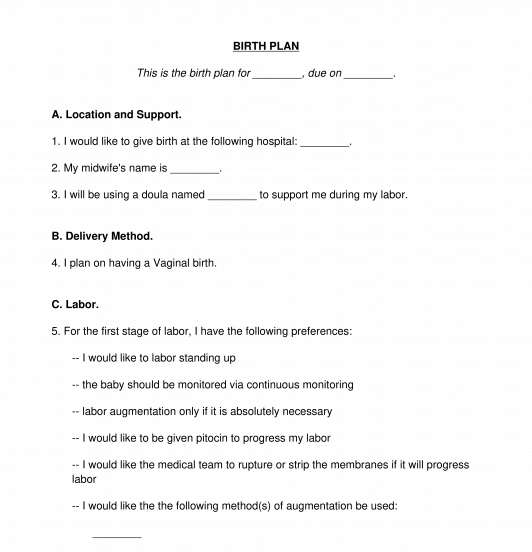 12/31/2024
12/31/2024

Answer a few questions and your document is created automatically.

Your document is ready! You will receive it in Word and PDF formats. You will be able to modify it.

 12/31/2024
12/31/2024
 Word and PDF
Word and PDF
 2 to 3 pages
2 to 3 pages



A Birth Plan is a document used by an expectant parent that details their preferences for the childbirth process and their time immediately after. The person who is giving birth, known as the birthing parent, is usually the person who makes the birth plan. However, it may be made with the assistance of a partner, doula, or labor coach. The birth plan functions as a checklist of topics to consider in terms of the birthing parent's preferences for their birth experience. The birth plan covers a range of topics, from the location where the birth will happen to who is on the birth team to the birthing parent's preferences for labor, delivery, cesarean birth, and any potential interventions. The birth plan also outlines visitor guidelines instructions for care of the baby after it is born.
Before creating the birth plan, it is helpful to know the due date or induction date and where the birthing parent plans for the baby to be born. The birthing parent should also spend some time thinking about and have an idea of their preferences for pain management and after care. For birthing parents who are not already anticipating or planning for a c-section, they should consider their preferences in case a cesarean delivery becomes unavoidable. The completed birth plan helps the birthing parent cover their bases so the birth team has a clear idea of their preferences in a variety of possible situations.
It is important to remember that a birth plan is just a plan and even the best laid plans can go awry in the case of emergency or other unexpected events. Furthermore, the birthing parent should check with the hospital, birth center, or wherever else they plan to give birth to be sure their preferences can be honored. Especially during the covid pandemic, hospital rules and regulations change quickly and often and could possibly affect the feasibility of some of the choices made in the birth plan.
How to use this document
This document contains everything necessary for a birthing parent to detail all of their childbirth and postpartum preferences. The birth plan covers the following important information:
Once the birthing parent has gone through and completed the entire birth plan, either alone or with the assistance of a partner, doula, or labor coach, they should make copies of the birth plan to be given to everyone on the birth team, including their care providers and anyone else who will be in the room during labor and delivery. If they have one, the birthing parent should also attach copies of their Advance Healthcare Directive to the birth plan. That way, medical staff will have knowledge of the birthing parent's preferences for their own medical treatment outside of just the labor and delivery process if the birthing parent is for some reason incapacitated or otherwise unable to communicate their wishes in the moment.
Applicable law
There is no applicable law controlling what must or most not be in a birth plan. However, all hospitals, birth centers, and other medical establishments have their own rules, regulations, and guidelines that could potentially impact what wish they are or are not able to honor. This is especially true during the coronavirus pandemic as the situation changes rapidly and drastically and hospital rules change to reflect the situation.
How to modify the template
You fill out a form. The document is created before your eyes as you respond to the questions.
At the end, you receive it in Word and PDF formats. You can modify it and reuse it.
Birth Plan - FREE - Sample, template - Word & PDF
Country: United States